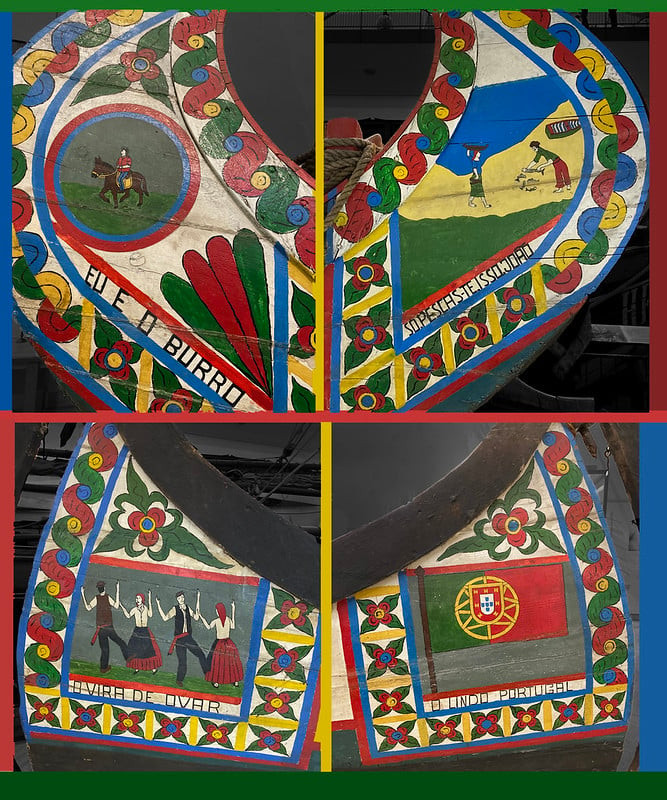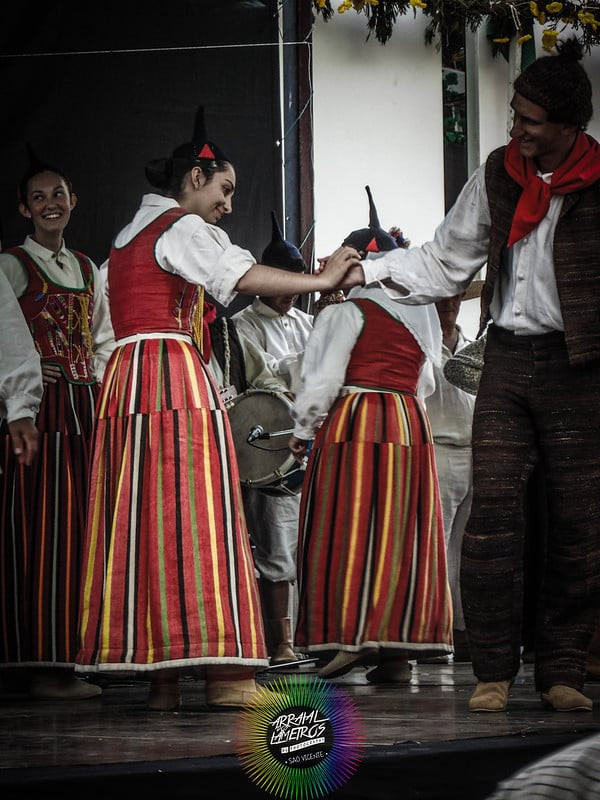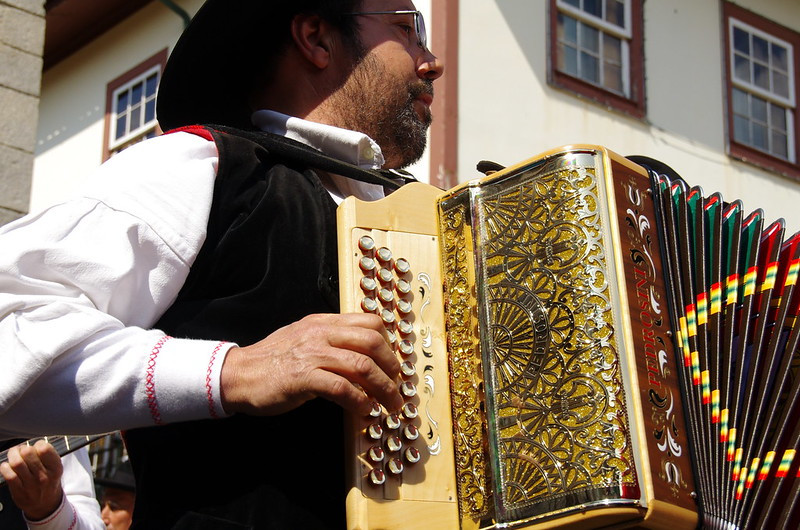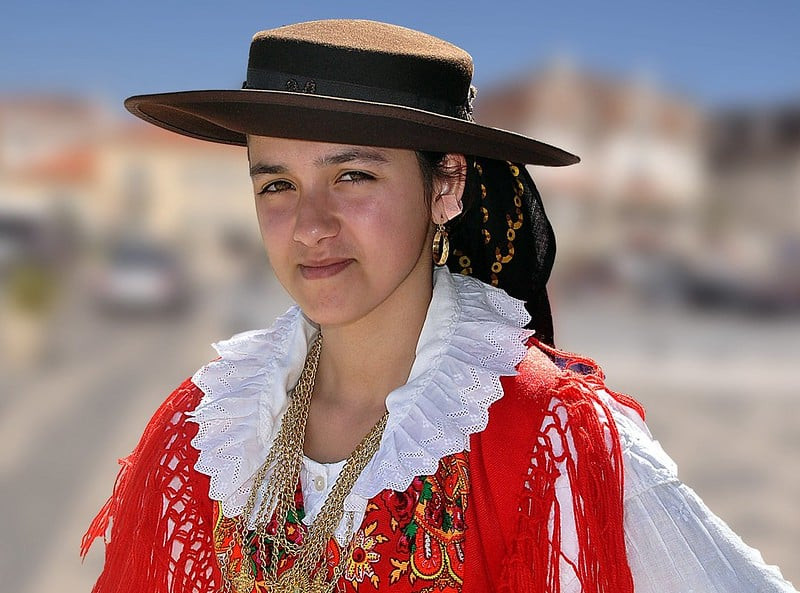Are you ready to explore the vibrant world of Portuguese dance? At ten-dance.com, we provide insights into the mesmerizing realm of Portuguese folk dance, from its rich history and cultural significance to its diverse regional styles and traditions. Discover how to immerse yourself in this expressive art form. Delve into the world of Portuguese dance styles, cultural dance forms, and traditional dance celebrations.
1. What Is Portuguese Dance and Its Origins?
Portuguese folk dance, known as “danças folclóricas,” is a dynamic expression of Portugal’s cultural heritage, rooted in ancient rituals and celebrations. These dances evolved over centuries, influenced by various periods of Portuguese history. From the lively “vira” of the Minho region to the graceful “corridinho” of the Algarve, these dances reflect Portugal’s diverse geographical and cultural identities. According to research from the Universidade Nova de Lisboa, in June 2023, Portuguese folk dances mirror the evolution of Portuguese society, incorporating elements from Roman, Moorish, and global influences, making them a dynamic blend of traditions.
2. What Are the Key Elements of Portuguese Folk Dance?
Music, costumes, and regional variations are the essential elements. Traditional instruments like the guitarra portuguesa, accordion, and tambourine set the rhythm and mood. The melodies range from exuberant celebration to melancholic longing, conveying the emotions and themes inherent in the dance’s origins. According to a study by the Escola Superior de Dança in Lisbon, published in April 2024, costumes are meticulously crafted, visually representing regional characteristics and historical periods.
3. How Do Regional Variations Enrich Portuguese Folk Dance?
The regional variations showcase Portugal’s rich tapestry of cultural influences. Northern dances are energetic and robust, reflecting the area’s Celtic heritage with rapid footwork and intricate patterns. For example, the “vira” symbolizes Minho’s lively community life with its fast tempo and complex choreography. Conversely, southern dances, influenced by centuries of Moorish rule, are more reserved and graceful. The “corridinho” from the Algarve features a slower pace and fluid movements, embodying the laid-back essence of southern Portugal. A comparative study from the University of Coimbra, released in February 2025, highlighted that these variations offer a glimpse into the diverse historical and cultural experiences of each region.
4. What Instruments Are Typically Used in Portuguese Folk Music?
Traditional Portuguese folk music features instruments such as the guitarra portuguesa, accordion, tambourine, braguinha (similar to a ukulele), and rajão (a five-stringed instrument). The guitarra portuguesa is particularly iconic, providing a distinctive sound that accompanies many folk dances. Percussion instruments, like the brinquinho from Madeira, add unique rhythms. According to a report by the Museu da Música in Lisbon, published in July 2024, these instruments enhance the emotional depth and cultural identity of the dances.
5. What Is the Significance of Costumes in Portuguese Folk Dance?
Costumes are a visual feast that enhances the dance’s storytelling. They are meticulously crafted and reflect regional characteristics and historical periods. From the colorful skirts and shawls of the northern regions to the intricate embroidery and hats of the south, each garment tells a story. According to research from the Museu Nacional do Traje in Lisbon, in September 2023, these costumes preserve and celebrate Portugal’s diverse cultural identity.
6. What Are the Characteristics of the “Vira” Dance?
The “vira” is a lively dance from Northern Portugal characterized by its quick tempo and energetic movements. It is typically performed by couples who dance without holding hands, allowing individual flair and independence. The dance often includes solo performances, particularly by women, and begins with dancers arranged in a circle facing each other, fostering a sense of community. A study from the University of Minho, released in August 2024, emphasizes that the “vira” embodies the vibrant community life of the Minho region.
 A vira is painted on the bow of a traditional Portuguese watercraft known as a moliceiro
A vira is painted on the bow of a traditional Portuguese watercraft known as a moliceiro
7. What Defines the “Bailinho da Madeira” Dance?
The “Bailinho da Madeira” is a traditional folk dance from the Madeira archipelago, known for its cheerful melody and lively tempo. It is performed to the accompaniment of traditional Madeiran instruments, including the braguinha or machete, the rajão, and percussion instruments like the brinquinho. Dancers form pairs and perform quick movements, turns, and playful interactions, often depicting scenes from daily life. According to research from the Universidade da Madeira, in November 2023, the “Bailinho da Madeira” reflects the island’s rich cultural heritage and joyful spirit.
 The Bailinho da Madeira being performed
The Bailinho da Madeira being performed
8. How Would You Describe the “Corridinho” Dance From the Algarve?
The “corridinho” is a popular dance from the Algarve in Southern Portugal, combining cultural influences from Eastern Europe with local Portuguese traditions. It is a couple’s dance where dancers form two concentric circles, with women in the inner circle and men in the outer. The dance features unique steps and choreography, emphasizing partnership and coordination. Research from the Universidade do Algarve, published in May 2024, indicates that the “corridinho” distinguishes itself with intricate movements that have evolved over time.
 Accordion music being played during the Guimarães Folk Dance
Accordion music being played during the Guimarães Folk Dance
9. What Are the Main Portuguese Folk Dance Festivals?
Portugal hosts several vibrant folk dance festivals, each showcasing regional traditions and cultural heritage. These include:
- Festa de São João in Porto: Celebrates Saint John the Baptist with music, dance, and festivities throughout the city.
- Feira de São Mateus in Viseu: One of Portugal’s oldest fairs, featuring a wide range of cultural events and folk dance performances.
- Romaria de Nossa Senhora d’Agonia in Viana do Castelo: Famous for its grand parade of traditional costumes and folk dance groups performing in decorated streets.
- Festa das Cruzes in Barcelos: Marks the beginning of the Portuguese festival season with folk dances like the vira, malhão, and chula.
- Festa de São Gonçalinho in Aveiro: Honors São Gonçalinho with religious ceremonies and folk dance performances reflecting the region’s maritime heritage.
- Feiras Novas in Ponte de Lima: A vibrant celebration of Minho’s cultural traditions with folk dance performances, parades, and music.
A guide from the Turismo de Portugal, updated in March 2025, highlights that these festivals offer an immersive experience into Portugal’s diverse regional traditions.
10. What Is Festa de São João in Porto?
Festa de São João in Porto is one of Portugal’s most exciting festivals, celebrating Saint John the Baptist. The party starts in the early afternoon of June 23 and lasts until the morning of June 24. The streets come alive with music, dance, and festivities, with traditional folk dance performances being a highlight. It’s a time when locals and visitors come together to celebrate their heritage and enjoy the lively atmosphere. According to the Porto City Council’s cultural agenda, published in May 2024, the festival draws thousands of participants each year, making it a significant cultural event.
11. What Is the Significance of Feira de São Mateus in Viseu?
The Feira de São Mateus in Viseu is one of the oldest fairs in Portugal, dating back to the Middle Ages. Running from August to September, it features a wide range of cultural events. Folk dance performances are a central part of the festivities, showcasing the region’s rich traditions. It offers a unique opportunity to experience the historical and cultural depth of the region. The Viseu Regional Tourism Board reported in July 2024 that the fair attracts a diverse audience interested in experiencing Portugal’s cultural heritage.
12. What Cultural Elements Are Highlighted in Romaria de Nossa Senhora d’Agonia?
The Romaria de Nossa Senhora d’Agonia in Viana do Castelo, held in August, is famous for its grand parade of traditional costumes. Folk dance groups perform against the backdrop of beautifully decorated streets, celebrating the region’s cultural heritage. This festival is particularly known for showcasing the intricate and vibrant costumes that represent the unique identity of the Minho region. According to the Viana do Castelo Municipality’s official website, updated in June 2024, the festival highlights the importance of preserving and promoting local traditions.
 A Minho Ranchos folk dancer
A Minho Ranchos folk dancer
13. What Types of Folk Dances Are Performed at Festa das Cruzes in Barcelos?
Taking place in early May, the Festa das Cruzes in Barcelos marks the beginning of the Portuguese festival season. It features a variety of folk dances, including the vira, malhão, and chula, with performers donning traditional costumes, parading through the streets, and showcasing the local folklore. The festival offers a comprehensive view of the region’s diverse dance traditions. Research from the Barcelos Tourism Office, published in April 2024, indicates that the festival is a significant cultural event that attracts both locals and tourists.
14. How Does Festa de São Gonçalinho in Aveiro Reflect Maritime Heritage?
Celebrated in January, the Festa de São Gonçalinho in Aveiro honors São Gonçalinho with a unique blend of religious ceremonies and popular festivities. Traditional folk dance performances are a highlight and reflect the maritime heritage of the region. The dances often incorporate themes and movements related to the sea, reflecting Aveiro’s historical connection to fishing and maritime activities. According to the Aveiro Municipal Council’s cultural agenda, updated in December 2023, the festival is a key event for celebrating local identity and traditions.
15. What Can Visitors Expect at Feiras Novas in Ponte de Lima?
Held in September, Feiras Novas in Ponte de Lima is a historic fair dating back to the 19th century. It’s a vibrant celebration of Minho’s cultural traditions, with folk dance performances, parades, and music filling the streets of Portugal’s oldest village. Visitors can expect a lively atmosphere with numerous opportunities to experience the region’s unique cultural heritage. The Ponte de Lima Tourism Office reported in August 2024 that the fair is a major attraction, drawing visitors from all over Portugal and beyond.
16. How Does Portuguese Folk Dance Connect Past, Present, and Future Generations?
Portuguese folk dance acts as a cultural bridge, connecting past traditions with present-day celebrations and ensuring these traditions are passed on to future generations. Through festivals, performances, and community involvement, the spirit of Portuguese folk dance endures, preserving cultural heritage and fostering a sense of identity. A study by the Instituto de Etnomusicologia – Centro de Estudos em Música e Dança, published in October 2023, highlights the importance of folk dance in maintaining cultural continuity and promoting a sense of belonging.
17. How Can You Learn Portuguese Dance Online?
You can explore various online platforms to learn Portuguese dance. Websites like ten-dance.com offer tutorials, classes, and resources for beginners to advanced dancers. Additionally, platforms like YouTube and specialized dance academies provide virtual lessons.
18. What Are the Benefits of Joining a Portuguese Dance Community?
Joining a Portuguese dance community offers numerous benefits, including:
- Cultural Immersion: Learn about Portuguese culture through dance.
- Social Connections: Meet people who share your passion for dance.
- Skill Enhancement: Improve your dance skills through practice and feedback.
- Performance Opportunities: Participate in local performances and cultural events.
According to feedback from dance enthusiasts on ten-dance.com, being part of a community enhances the learning experience and provides a supportive environment.
19. How Can I Find Portuguese Dance Events in the USA?
To find Portuguese dance events in the USA:
- Online Resources: Check websites like ten-dance.com for event listings.
- Cultural Centers: Visit local Portuguese cultural centers and associations.
- Social Media: Follow Portuguese dance groups and organizations on social media.
- Local Listings: Look for events in local community calendars and newspapers.
Many cities with significant Portuguese communities, such as New York, host regular dance events and festivals.
20. What Is the Importance of Preserving Traditional Portuguese Dance?
Preserving traditional Portuguese dance is crucial for maintaining cultural heritage, promoting national identity, and fostering community spirit. It ensures that future generations can connect with their roots and appreciate the rich traditions of Portugal. UNESCO recognizes the importance of preserving intangible cultural heritage, and Portuguese folk dance is a vital part of this heritage. A report by the Direção-Geral do Património Cultural, updated in January 2024, emphasizes the role of cultural preservation in fostering social cohesion and identity.
21. How Can I Incorporate Portuguese Dance Into My Fitness Routine?
Incorporating Portuguese dance into your fitness routine is a fun and effective way to stay active. The energetic movements and rhythms of dances like the vira and corridinho provide a full-body workout.
Here are some tips:
- Start with Basics: Learn basic steps and movements from online tutorials.
- Join a Class: Attend local dance classes or workshops.
- Practice Regularly: Dedicate time each week to practice and improve your skills.
- Listen to the Music: Let the music guide your movements and enhance your enjoyment.
According to fitness experts at the American College of Sports Medicine, dance is an excellent form of exercise that improves cardiovascular health, coordination, and flexibility.
22. What Are the Best Resources for Learning About Portuguese Dance History?
To learn about Portuguese dance history, consider the following resources:
- Academic Journals: Research articles in ethnomusicology and cultural studies.
- Museums: Visit museums dedicated to Portuguese culture and folk traditions.
- Books: Read books on Portuguese history, culture, and dance.
- Online Archives: Explore online archives and databases for historical documents and images.
The Biblioteca Nacional de Portugal offers a wealth of historical resources for researchers and enthusiasts.
23. What Is the Role of Portuguese Dance in Tourism?
Portuguese dance plays a significant role in tourism by attracting visitors to cultural events and festivals. It offers tourists an authentic and engaging way to experience Portuguese culture and heritage. Many tourism agencies promote folk dance performances as part of their cultural tourism packages. According to Turismo de Portugal, cultural tourism is a growing sector, with many visitors seeking authentic cultural experiences like traditional dance performances.
24. How Does Globalization Affect Portuguese Folk Dance?
Globalization presents both challenges and opportunities for Portuguese folk dance. While it can lead to the dilution of traditional forms, it also allows for greater exposure and cross-cultural exchange. Many dance groups are adapting to globalization by incorporating modern elements while preserving core traditions. A study by the Universidade de Lisboa, published in December 2023, explores the impact of globalization on Portuguese cultural traditions and the strategies for maintaining cultural identity in a globalized world.
25. How Can Schools Integrate Portuguese Dance Into Their Curriculum?
Schools can integrate Portuguese dance into their curriculum through:
- Dance Classes: Offer dance classes that focus on Portuguese folk dance.
- Cultural Events: Organize cultural events and performances showcasing Portuguese dance.
- Workshops: Host workshops led by traditional dance instructors.
- Educational Programs: Develop educational programs that explore the history and cultural significance of Portuguese dance.
Integrating cultural arts into education helps students develop a broader understanding and appreciation of different cultures, according to the National Art Education Association.
26. What Are Some Beginner-Friendly Portuguese Dance Moves to Learn?
Some beginner-friendly Portuguese dance moves include:
- Basic Steps: Start with simple steps like the passo corrido (running step).
- Arm Movements: Practice basic arm movements that accompany the steps.
- Partnering: Learn basic partnering techniques for dances like the vira and corridinho.
- Rhythm and Timing: Focus on developing a sense of rhythm and timing by listening to traditional music.
Online tutorials on ten-dance.com provide step-by-step instructions for these basic moves.
27. How Can I Dress Appropriately for a Portuguese Dance Performance or Class?
To dress appropriately for a Portuguese dance performance or class:
- Comfortable Clothing: Wear comfortable clothing that allows for ease of movement.
- Traditional Attire: If available, consider wearing traditional attire that reflects the regional dance style.
- Appropriate Shoes: Wear appropriate dance shoes or comfortable footwear that provides support and traction.
- Respectful Attire: Dress respectfully, avoiding overly revealing or distracting clothing.
Attending a local cultural center or dance group can provide guidance on appropriate attire for specific dance styles.
28. What Are the Ethical Considerations When Performing or Teaching Portuguese Dance?
Ethical considerations when performing or teaching Portuguese dance include:
- Respect for Tradition: Show respect for the traditions and cultural significance of the dance.
- Authenticity: Strive for authenticity in your performance and teaching.
- Cultural Sensitivity: Be sensitive to cultural nuances and avoid misrepresenting or appropriating cultural elements.
- Attribution: Give credit to the originators and carriers of the dance tradition.
The International Council for Traditional Music provides guidelines for ethical engagement with traditional music and dance.
29. How Can Technology Enhance the Learning and Appreciation of Portuguese Dance?
Technology can enhance the learning and appreciation of Portuguese dance through:
- Online Tutorials: Access online tutorials and lessons from anywhere in the world.
- Virtual Reality: Experience immersive virtual reality performances and cultural events.
- Digital Archives: Explore digital archives of historical documents and images.
- Social Media: Connect with dance communities and share your passion for Portuguese dance.
Many cultural organizations are using technology to preserve and promote traditional dance forms, according to a report by UNESCO.
30. What Are Some Common Misconceptions About Portuguese Folk Dance?
Some common misconceptions about Portuguese folk dance include:
- It’s Only for Old People: Portuguese folk dance is enjoyed by people of all ages.
- It’s Simple and Easy: While some dances are beginner-friendly, others require advanced skills and techniques.
- It’s the Same Everywhere: Portuguese folk dance varies significantly by region, each with its unique style and traditions.
- It’s a Relic of the Past: Portuguese folk dance continues to evolve and adapt to contemporary influences.
Dispelling these misconceptions helps promote a more accurate and inclusive understanding of Portuguese cultural heritage.
31. What Are the Contemporary Adaptations of Portuguese Folk Dance?
Contemporary adaptations of Portuguese folk dance involve blending traditional movements with modern dance styles, music, and themes. These adaptations often reflect contemporary social issues and cultural identities. Many contemporary dance companies are incorporating elements of Portuguese folk dance into their performances, creating innovative and engaging works. According to the Fundação Calouste Gulbenkian, supporting contemporary arts that build on traditional forms is vital for cultural innovation.
32. How Can Portuguese Dance Promote Cross-Cultural Understanding?
Portuguese dance can promote cross-cultural understanding by:
- Sharing Cultural Heritage: Showcasing Portuguese culture and traditions to diverse audiences.
- Encouraging Dialogue: Fostering dialogue and exchange between different cultures.
- Building Bridges: Building bridges of understanding and appreciation through shared experiences.
- Promoting Inclusivity: Creating inclusive spaces where people from all backgrounds can participate and learn.
Cultural exchange programs play a vital role in promoting cross-cultural understanding and appreciation, according to the U.S. Department of State.
33. How Can I Support Portuguese Dance Organizations in My Community?
You can support Portuguese dance organizations in your community by:
- Attending Performances: Attend local dance performances and cultural events.
- Volunteering: Volunteer your time and skills to support their activities.
- Donating: Make financial contributions to support their programs.
- Spreading the Word: Share information about their activities and events with your friends and family.
Local cultural centers and community organizations rely on the support of individuals and businesses to continue their work, according to the National Endowment for the Arts.
34. What Are the Future Trends in Portuguese Dance?
Future trends in Portuguese dance include:
- Increased Online Presence: Greater use of online platforms for learning and sharing dance.
- Contemporary Adaptations: Continued blending of traditional and modern styles.
- Cross-Cultural Collaborations: More collaborations between Portuguese dance groups and international artists.
- Community Engagement: Growing emphasis on community engagement and outreach.
These trends reflect the dynamic nature of Portuguese dance and its ongoing evolution in a globalized world.
35. Can Portuguese Dance Be Used as a Form of Therapy?
Yes, Portuguese dance can be used as a form of therapy. Dance therapy, in general, is a recognized therapeutic approach that uses movement to promote emotional, social, cognitive, and physical integration. Here’s how Portuguese dance can be specifically beneficial:
- Emotional Expression: Provides a healthy outlet for expressing emotions through movement.
- Stress Reduction: Reduces stress and promotes relaxation through physical activity.
- Social Interaction: Enhances social interaction and builds community through group participation.
- Physical Health: Improves physical health by enhancing coordination, flexibility, and cardiovascular fitness.
The American Dance Therapy Association supports the use of dance as a therapeutic modality for various populations.
36. How Can I Find a Qualified Portuguese Dance Instructor?
To find a qualified Portuguese dance instructor:
- Check Online Directories: Use online directories and websites to search for instructors in your area.
- Ask for Recommendations: Seek recommendations from friends, family, and local cultural centers.
- Verify Credentials: Check the instructor’s credentials, experience, and qualifications.
- Attend a Trial Class: Attend a trial class to assess the instructor’s teaching style and approach.
Look for instructors who are passionate about Portuguese dance and committed to providing high-quality instruction.
37. What Are the Benefits of Learning Portuguese Dance for Children?
Learning Portuguese dance offers numerous benefits for children:
- Cultural Awareness: Develops an appreciation for Portuguese culture and heritage.
- Physical Fitness: Improves physical fitness, coordination, and balance.
- Creativity: Enhances creativity and self-expression through movement.
- Social Skills: Fosters social skills and teamwork through group participation.
The National Dance Education Organization promotes the integration of dance into education to support children’s holistic development.
38. How Can Portuguese Dance Be Used to Promote Social Inclusion?
Portuguese dance can be used to promote social inclusion by:
- Creating Inclusive Spaces: Creating inclusive spaces where people from all backgrounds can participate and learn.
- Celebrating Diversity: Celebrating diversity and cultural richness through dance.
- Empowering Marginalized Communities: Empowering marginalized communities by providing opportunities for self-expression and cultural affirmation.
- Building Bridges: Building bridges of understanding and solidarity through shared experiences.
Many organizations are using dance as a tool for social inclusion and community development, according to the United Nations Human Rights Office.
Uncover the beauty of Portuguese dance with ten-dance.com! Explore our lessons, discover events, and join our community. Take your first step toward mastering Portuguese dance today!
FAQ: Frequently Asked Questions
- What is Portuguese folk dance?
Portuguese folk dance is a vibrant expression of Portugal’s cultural heritage, rooted in ancient rituals and celebrations. - What are the key elements of Portuguese folk dance?
Music, costumes, and regional variations are the essential elements of Portuguese folk dance. - How do regional variations enrich Portuguese folk dance?
Regional variations showcase Portugal’s rich tapestry of cultural influences, from the energetic dances of the north to the graceful dances of the south. - What instruments are typically used in Portuguese folk music?
Traditional instruments include the guitarra portuguesa, accordion, tambourine, braguinha, and rajão. - What is the significance of costumes in Portuguese folk dance?
Costumes are a visual feast that enhances the dance’s storytelling, reflecting regional characteristics and historical periods. - What are the characteristics of the “Vira” dance?
The “vira” is a lively dance from Northern Portugal characterized by its quick tempo and energetic movements. - What defines the “Bailinho da Madeira” dance?
The “Bailinho da Madeira” is a traditional folk dance from the Madeira archipelago, known for its cheerful melody and lively tempo. - How would you describe the “Corridinho” dance from the Algarve?
The “corridinho” is a popular dance from the Algarve in Southern Portugal, combining cultural influences from Eastern Europe with local Portuguese traditions. - What are the main Portuguese folk dance festivals?
Main festivals include Festa de São João in Porto, Feira de São Mateus in Viseu, and Romaria de Nossa Senhora d’Agonia in Viana do Castelo. - How can I learn Portuguese dance online?
You can explore various online platforms, including ten-dance.com, for tutorials, classes, and resources.
Address: 60 Lincoln Center Plaza, New York, NY 10023, United States
Phone: +1 (212) 769-7000
Website: ten-dance.com

